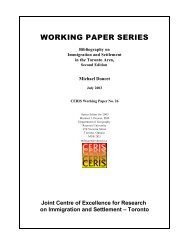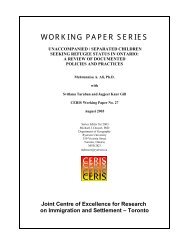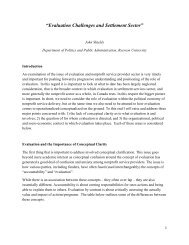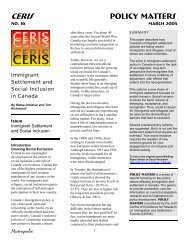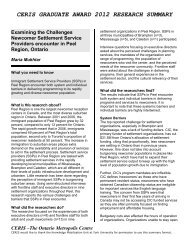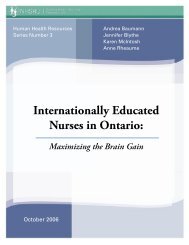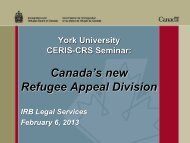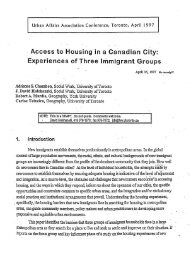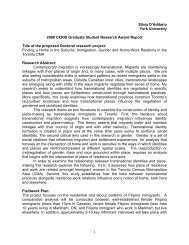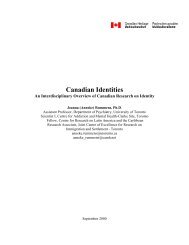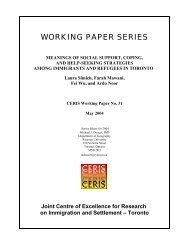A second policy concern <strong>in</strong>volves <strong>the</strong> elderly. Their numbers also vary dramatically among ethnoracialgroups, especially <strong>in</strong> <strong>the</strong> 75 and older category, who tend to have greater needs for social supportthan <strong>the</strong> “young old” between 65 and 74. For some very young ethno-racial groups, such as <strong>the</strong> Africans,<strong>the</strong> challenges <strong>of</strong> an ag<strong>in</strong>g population are far <strong>of</strong>f, but many o<strong>the</strong>r groups with few elderly have largeproportions <strong>of</strong> people <strong>in</strong> late middle age. One way to see <strong>the</strong> extent <strong>of</strong> this demographic concern is tocompare <strong>the</strong> proportions <strong>of</strong> a group between 45 and 64 and over <strong>the</strong> age <strong>of</strong> 65. In <strong>the</strong> “mature” Europeangroups, whose fertility is near <strong>the</strong> replacement level, <strong>the</strong>re are about four people <strong>in</strong> <strong>the</strong> 45-64 group foreach three people 65 and over. Compare this to <strong>the</strong> Koreans, with 23.5 and 7.5 percent <strong>in</strong> <strong>the</strong> two groups,respectively. The Ch<strong>in</strong>ese population, with 20.6 percent and 10.8 percent, respectively, between 45 and64 and 65 and older, will shortly have a substantially larger elderly population. A number <strong>of</strong> Sou<strong>the</strong>rnEuropean groups also face large <strong>in</strong>creases <strong>in</strong> <strong>the</strong>ir retirement age populations <strong>in</strong> <strong>the</strong> next few years.Age<strong>in</strong>g will also affect Africans, Blacks and Caribbeans, <strong>the</strong>re are 15.3 percent aged 45-64, compared toonly 4.2 percent 65 or older.Immigration and EthnicityAs Table 2 shows, ethno-racial groups vary dramatically <strong>in</strong> <strong>the</strong> proportion <strong>of</strong> immigrants, and <strong>the</strong>differences would be even larger if young children born <strong>in</strong> Canada were excluded. At <strong>the</strong> extremes, 99.1percent <strong>of</strong> Aborig<strong>in</strong>al people are born <strong>in</strong> Canada (<strong>the</strong> small rema<strong>in</strong><strong>in</strong>g number are US-born), whereasmore than one fifth <strong>of</strong> <strong>the</strong> Somalis, Pakistanis and Bangladeshis, Sri Lankans, Tamils, Egyptians,Romanians, Russians and Serbians who answered <strong>the</strong> Census <strong>in</strong> May 1996 had arrived s<strong>in</strong>ce 1994.RECENT ARRIVALSThe Table divides immigrants <strong>in</strong>to four categories <strong>of</strong> arrival <strong>in</strong> Canada: before 1976, 1976-1985,1986-1993 and 1994-1996. There were a number <strong>of</strong> groups <strong>in</strong> which 15 percent or more <strong>of</strong> <strong>the</strong>population arrived between 1994 and <strong>the</strong> Census report<strong>in</strong>g date <strong>in</strong> May 1996, <strong>in</strong>clud<strong>in</strong>g: Ghanaians,Somalis, Pakistanis and Bangladeshis (comb<strong>in</strong>ed), Sri Lankans, Tamils and people with multiple SouthAsian orig<strong>in</strong>s, Filip<strong>in</strong>os, Afghans, Egyptians, Iranians, Turks, people from “o<strong>the</strong>r” Arab and West Asiannations, Romanians and Russians, Serbians, Yugoslavs and “o<strong>the</strong>r” Sou<strong>the</strong>rn European nations. Thesevery recent immigrants make up 5.7 percent <strong>of</strong> <strong>the</strong> <strong>Toronto</strong> population. This number can be compared to<strong>the</strong> 7.9 percent <strong>of</strong> <strong>the</strong> <strong>Toronto</strong> population who said <strong>the</strong>y came to <strong>Toronto</strong> <strong>in</strong> <strong>the</strong> eight previous yearsbetween 1986 and 1994.<strong>Ethno</strong>-<strong>Racial</strong> <strong>Inequality</strong> <strong>in</strong> <strong>Toronto</strong>: <strong>An</strong>alysis <strong>of</strong> <strong>the</strong> 1996 Census 25
ARRIVALS BETWEEN 1976 AND 1993A number <strong>of</strong> groups experienced high levels <strong>of</strong> immigration between 1986 and 1993. <strong>Ethno</strong>-racialgroups with 25 percent or more <strong>of</strong> <strong>the</strong>ir population arriv<strong>in</strong>g <strong>in</strong> this period <strong>in</strong>clude <strong>the</strong> Ethiopians,Ghanaians, Somalis, Pakistanis and Bangladeshis, Sri Lankans, Tamils, <strong>the</strong> multiple South Asian group;Afghans, Lebanese, Iranians, Turks, o<strong>the</strong>r Arabs and West Asians; Central Americans, Romanians,Serbians and “o<strong>the</strong>r” Sou<strong>the</strong>rn Europeans. Many <strong>of</strong> <strong>the</strong> 1986-93 immigrants will have Canadian-bornchildren, so that more than 25 percent <strong>of</strong> <strong>the</strong> adults would have arrived dur<strong>in</strong>g this period.More than one-quarter <strong>of</strong> <strong>the</strong> entire African, Black and Caribbean, South Asian, East and Sou<strong>the</strong>astAsian, and Lat<strong>in</strong> American populations <strong>in</strong> <strong>Toronto</strong> arrived between 1976 and 1985; <strong>in</strong>deed 16.0 percent<strong>of</strong> all <strong>Toronto</strong>nians came to Canada <strong>in</strong> this period. Individual groups have even more sharply-def<strong>in</strong>edperiods <strong>of</strong> arrival. For example, 44.4 percent <strong>of</strong> <strong>the</strong> Ethiopians arrived between 1976 and 1985, alongwith 40.2 percent <strong>of</strong> <strong>the</strong> Guyanese, 52.6 percent <strong>of</strong> Vietnamese, and 47.8 percent <strong>of</strong> <strong>the</strong> “o<strong>the</strong>r” East andSou<strong>the</strong>ast Asians (<strong>in</strong>clud<strong>in</strong>g Cambodians and Laotians), 51.1 percent <strong>of</strong> people with two or more East andSou<strong>the</strong>ast Asian orig<strong>in</strong>s, and 40.6 percent <strong>of</strong> <strong>the</strong> Central Americans. One sees immediately <strong>the</strong>correlation between <strong>the</strong>se figures and civil wars dur<strong>in</strong>g that period.ARRIVALS BEFORE 1976About one fifth <strong>of</strong> all <strong>Toronto</strong>nians were born outside Canada, but arrived at least 20 years ago.These <strong>in</strong>clude a very large number <strong>of</strong> Europeans, 24.5 percent <strong>of</strong> whom were immigrants arriv<strong>in</strong>g before1976. More than 40 percent <strong>of</strong> Nor<strong>the</strong>rn Europeans (exclud<strong>in</strong>g British and French) and Sou<strong>the</strong>rnEuropeans immigrated to Canada before 1976. In a number <strong>of</strong> cases, <strong>the</strong>se immigrants account for morethan half <strong>the</strong> population: 57.0 percent <strong>of</strong> Austrians, 49.9 percent <strong>of</strong> F<strong>in</strong>ns, 66.6 percent <strong>of</strong> Estonians, 63.5percent <strong>of</strong> Latvians, 54.8 percent <strong>of</strong> Lithuanians, 51.9 percent <strong>of</strong> Hungarians, along with more than 45percent <strong>of</strong> <strong>the</strong> Croatians, Macedonians, Slovenians, Greeks, Italians, and Maltese.<strong>Ethno</strong>-<strong>Racial</strong> <strong>Inequality</strong> <strong>in</strong> <strong>Toronto</strong>: <strong>An</strong>alysis <strong>of</strong> <strong>the</strong> 1996 Census 26
- Page 6 and 7: origin, South Asians, Arab and West
- Page 8 and 9: Table of ContentsExecutive Summary.
- Page 10 and 11: IntroductionThis Report provides de
- Page 12 and 13: Methodological NotesThis Report pro
- Page 14 and 15: Chapter 1Defining Ethno-Racial Grou
- Page 16 and 17: question, described above. The “C
- Page 18 and 19: “Barbadians.” Likewise, people
- Page 20 and 21: acial identification question, redu
- Page 22 and 23: Table 1, continuedEthno-Racial Grou
- Page 24 and 25: percentage of a group has the need.
- Page 26 and 27: ARAB AND WEST ASIAN ORIGINSApproxim
- Page 28 and 29: EUROPEAN ORIGIN GROUPS TEND TO BE O
- Page 30 and 31: The key question involves the numbe
- Page 32 and 33: Table 2, continuedPercentage and Nu
- Page 36 and 37: NON-NATIONAL, “RACIAL” AND MULT
- Page 38 and 39: Table 3, continuedKnowledge of Engl
- Page 40 and 41: majority of people speak English. T
- Page 42 and 43: Fully 96.1 percent of Torontonians
- Page 44 and 45: Chapter 2EducationIf educational cr
- Page 46 and 47: Table 4, continuedHighest Level of
- Page 48 and 49: Ethno-Racial Inequality in Toronto:
- Page 50 and 51: Educational Attainment of AdultsAbo
- Page 52 and 53: EUROPEAN ORIGINAmong Europeans, edu
- Page 54 and 55: GROUPS WITH HIGHER PROPORTIONS OF N
- Page 56 and 57: Table 5, continuedSchool Attendance
- Page 58 and 59: Ethno-Racial Inequality in Toronto:
- Page 60 and 61: Of most concern are the small numbe
- Page 62 and 63: Not counted as unemployed are “di
- Page 64 and 65: Table 6, continuedLabour Force Char
- Page 66 and 67: Ethno-Racial Inequality in Toronto:
- Page 68 and 69: percent for the African, Black and
- Page 70 and 71: LATIN AMERICAN ORIGINSThe two Latin
- Page 72 and 73: Table 7, continuedIncome from Emplo
- Page 74 and 75: efore coming to Canada likely refle
- Page 76 and 77: Table 8a, continuedOccupations of W
- Page 78 and 79: Table 8bOccupations of Men by Ethno
- Page 80 and 81: Table 8b, continuedOccupations of M
- Page 82 and 83: Ethno-Racial Inequality in Toronto:
- Page 84 and 85:
eing an employee; just 3.2 percent
- Page 86 and 87:
Table 9, continuedIncidence of Self
- Page 88 and 89:
AFRICAN, BLACK AND CARIBBEAN ORIGIN
- Page 90 and 91:
esult in similar levels of income.
- Page 92 and 93:
Among the individual ethno-racial g
- Page 94 and 95:
Chapter 4Poverty and Individual and
- Page 96 and 97:
Introduction to the TablesThe first
- Page 98 and 99:
Table 10, continuedIncidence of Pov
- Page 100 and 101:
Ethno-Racial Inequality in Toronto:
- Page 102 and 103:
Table 11, continuedIncidence of Chi
- Page 104 and 105:
Ethno-Racial Inequality in Toronto:
- Page 106 and 107:
types of families are not an intuit
- Page 108 and 109:
children and 12.8 percent of Arab/W
- Page 110 and 111:
Table 12, continuedIncidence of Pov
- Page 112 and 113:
Southeast Asians and Pacific Island
- Page 114 and 115:
Table 13, continuedMedian Family In
- Page 116 and 117:
Ethno-Racial Inequality in Toronto:
- Page 118 and 119:
Table 14, continuedMedian Individua
- Page 120 and 121:
Ethno-Racial Inequality in Toronto:
- Page 122 and 123:
SOUTH ASIAN ORIGINSWhile just over
- Page 124 and 125:
LATIN AMERICAN ORIGINSDue to statis
- Page 126 and 127:
There are remarkable ethno-racial d
- Page 128 and 129:
Table 15, continuedHome Ownership o
- Page 130 and 131:
percent of Italian families own the
- Page 132 and 133:
The most severe disadvantage affect
- Page 134 and 135:
Men in Lower SkillJobs(Table 8b/Cha
- Page 136 and 137:
which included all other African na
- Page 138 and 139:
In Lower Skill Non-Manual Occupatio
- Page 140 and 141:
skilled non-manual occupations in 1
- Page 142:
segregation, the effects of unequal



